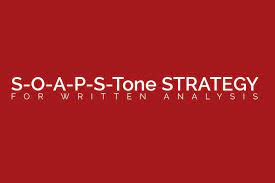Rhetoric will be the focus of reading and writing throughout our study of written and oral language during the fourth quarter. In order to maximize your understanding and perspective, you need to have a foundation for rhetorical strategies.
Rhetorical Triangle:

A model for rhetorical writing: In brief, “rhetoric” is any communication used to modify the perspectives of others.
Ethos, Lagos, Pathos
SOAPSTone (Speaker, Occasion, Audience, Purpose, Subject, Tone) is an acronym for a series of questions that students must first ask themselves, and then answer, as they begin to plan their compositions.
Who is the Speaker?
The voice that tells the story. Before students begin to write, they must decide whose voice is going to be heard. Whether this voice belongs to a fictional character or to the writers themselves, students should determine how to insert and develop those attributes of the speaker that will influence the perceived meaning of the piece.
What is the Occasion?
The time and the place of the piece; the context that prompted the writing. Writing does not occur in a vacuum. All writers are influenced by the larger occasion: an environment of ideas, attitudes, and emotions that swirl around a broad issue. Then there is the immediate occasion: an event or situation that catches the writer’s attention and triggers a response.
Who is the Audience?
The group of readers to whom this piece is directed. As they begin to write, students must determine who the audience is that they intend to address. It may be one person or a specific group. This choice of audience will affect how and why students write a particular text.
What is the Purpose?
The reason behind the text. Students need to consider the purpose of the text in order to develop the thesis or the argument and its logic. They should ask themselves, “What do I want my audience to think or do as a result of reading my text?”
What is the Subject?
Students should be able to state the subject in a few words or phrases. This step helps them to focus on the intended task throughout the writing process.
What is the Tone?
The attitude of the author. The spoken word can convey the speaker’s attitude and thus help to impart meaning through tone of voice. With the written word, it is tone that extends meaning beyond the literal, and students must learn to convey this tone in their diction (choice of words), syntax (sentence construction), and imagery (metaphors, similes, and other types of figurative language). The ability to manage tone is one of the best indicators of a sophisticated writer.
This strategy is not a substitute for the hard work and practice necessary for students to increase their skill in the use of language or in the development of individual writing styles. But it is an important first step.
by Ogden Morse
Academic Director
Way Interactive, Inc.

